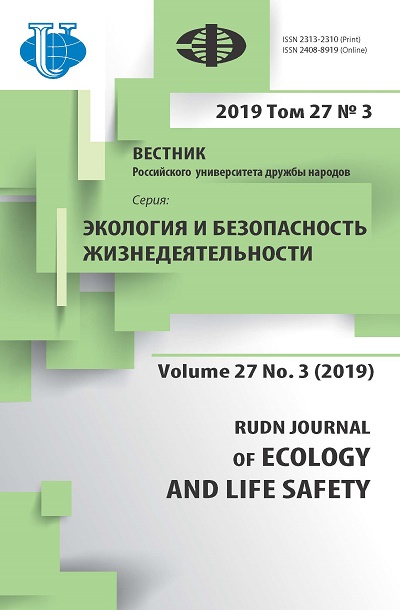Assessment of ecological comfort of soils of urban ecosystems under the influence of heavy metals on them
- Authors: Nevedrov N.P.1
-
Affiliations:
- Kursk State University
- Issue: Vol 27, No 3 (2019)
- Pages: 209-218
- Section: Environmetal defence
- URL: https://journals.rudn.ru/ecology/article/view/23910
- DOI: https://doi.org/10.22363/2313-2310-2019-27-3-209-218
Cite item
Full Text
Abstract
Assessment of the ecological state of environmental components in urban areas plays an important role in achieving environmental safety and environmental comfort for human habitation and economic activities. A comprehensive index of ecological comfort of soils polluted by heavy metals is presented and tested. The index is calculated by the ratio of the total impact of heavy metals (HM) on soils, plants, and soil biota to the sum of indicators of environmental sustainability of soils to this effect and the ability of soils to prevent HM pollution in nearby territories. The scale for ecological regulation and ecological comfort of urban ecosystem soils is proposed. It was noted that 42.8% of the soils of the studied key sites located in the sanitary-protective and recreational zones are environmentally comfortable, while 57.2% of the soils of the industrial, residential and sanitary-protective functional zones of the city are not considered to be ecologically comfortable.
About the authors
Nikolay P. Nevedrov
Kursk State University
Author for correspondence.
Email: 9202635354@mail.ru
SPIN-code: 7416-6152
Candidate of Biology Sciences, Research Scientist of Scientifically Research Laboratory of Environmental Monitoring
33 Radishcheva St., Kursk, 305000, Russian FederationReferences
- Ovchinnikova NG, Medvedkov DA. Problems of overpopulation of urbanized zones in the settlement system and their impact on the rational use of territories. Jekonomika i jekologija territorial'nyh obrazovanij. 2018;3(2):112–121.
- Kochurov BI. Ecodiagnostics and balanced development. Moscow, Smolensk, Magenta Publ.; 2003.
- Gerasimova MI, Stroganova MN, Mozharova NV, Prokofeva TV. Anthropogenous soils: genesis, geography, recultivation. Smolensk, Ojkumena Publ.; 2003.
- Smagin AV, Shoba SA, Makarov OA. Ecological assessment of soil resources and technology of their reproduction (on the example of Moscow). Moscow, Lomonosov Moscow State University Publ.; 2008.
- Nevedrov NP, Protsenko EP, Glebova IV. The Relationship between Bulk and Mobile Forms of Heavy Metals in Soils of Kursk. Eurasian Soil Science. 2018;1(51):112–119.
- Vodyanickij YuN. Standards for the contents of heavy metals and metalloids in soils. Pochvovedenie. 2012;3:368–375
- Korchagina KV, Smagin AV, Reshetina TV. New method of assessment of extent of pollution of soils zinc and lead taking into account changes of their concentration and density of addition on a profile of soils. Vestnik OGU. 2013;10(159):264–267.
- Kasprova JuA. Ecologically disadvantaged territories: in search of an optimal classification. Trudy Instituta gosudarstva i prava Rossijskoj akademii nauk. 2013;5:107–117.
- Kasjanenko AA. Modern methods of risk assessment in ecology. Moscow, RUDN University Publ.; 2008.
- Prokofeva TV, Martynenko IA, Ivannikov FA. Classification of Moscow soils and parent materials and its possible inclusion in the classification system of Russian soils. Pochvovedenie. 2011;5:611–623.
- Rossiter DG. Classification of urban and industrial soils in the world reference base for soil resources. J. Soils Sediments. 2007;7:96–100.
- Shishov LL, Tonkonogov VD, Lebedeva II, Gerasimova MI. Soil classification and diagnostics in Russia. Moscow, Ojkumena Publ.; 2004.
















